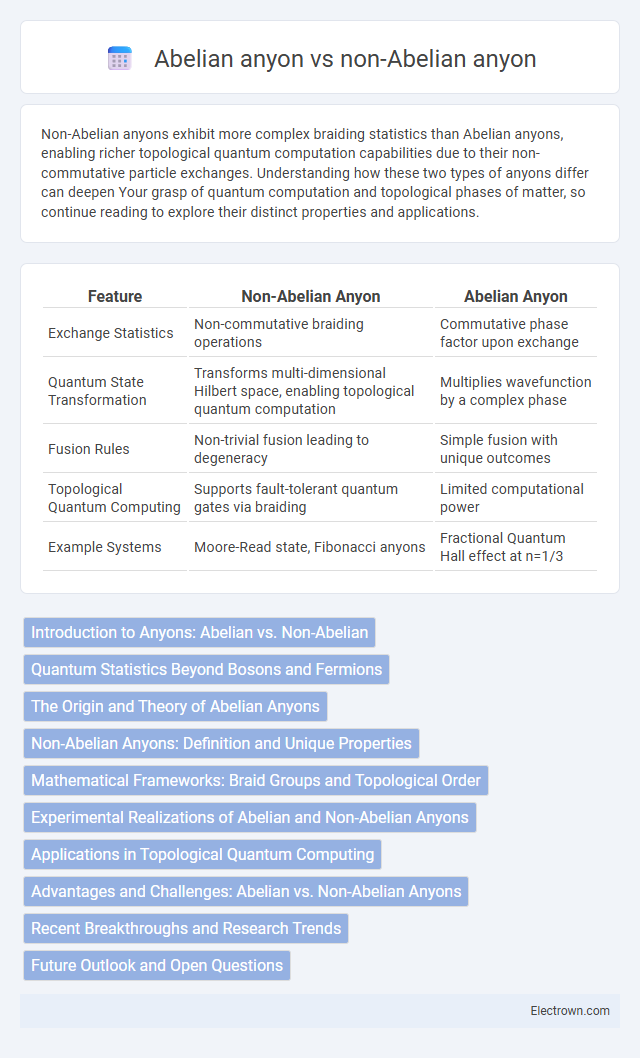Non-Abelian anyons exhibit more complex braiding statistics than Abelian anyons, enabling richer topological quantum computation capabilities due to their non-commutative particle exchanges. Understanding how these two types of anyons differ can deepen Your grasp of quantum computation and topological phases of matter, so continue reading to explore their distinct properties and applications.
Table of Comparison
| Feature | Non-Abelian Anyon | Abelian Anyon |
|---|---|---|
| Exchange Statistics | Non-commutative braiding operations | Commutative phase factor upon exchange |
| Quantum State Transformation | Transforms multi-dimensional Hilbert space, enabling topological quantum computation | Multiplies wavefunction by a complex phase |
| Fusion Rules | Non-trivial fusion leading to degeneracy | Simple fusion with unique outcomes |
| Topological Quantum Computing | Supports fault-tolerant quantum gates via braiding | Limited computational power |
| Example Systems | Moore-Read state, Fibonacci anyons | Fractional Quantum Hall effect at n=1/3 |
Introduction to Anyons: Abelian vs. Non-Abelian
Anyons are quasiparticles existing in two-dimensional systems with unique quantum statistics that differ from fermions and bosons. Abelian anyons exhibit phase changes described by a single complex number when braided, while non-Abelian anyons have richer transformations encoded by matrices, enabling topologically protected quantum states. Your understanding of these distinctions is crucial for advancements in fault-tolerant quantum computing and topological quantum matter research.
Quantum Statistics Beyond Bosons and Fermions
Non-Abelian anyons exhibit quantum statistics beyond traditional bosons and fermions by allowing particle exchanges to transform the system's state in a non-commutative manner, making them crucial for topological quantum computation. Abelian anyons, in contrast, accumulate a simple phase factor during exchanges, representing a more limited form of quantum statistics. Your understanding of quantum mechanics expands significantly by studying these exotic particles, which reveal the rich possibilities of two-dimensional quantum systems.
The Origin and Theory of Abelian Anyons
Abelian anyons arise from the fractional statistics of quasiparticles in two-dimensional systems, where exchanging two identical particles results in a phase shift in the wavefunction, characterized by Abelian braid groups. Their theoretical foundation originates in the quantum Hall effect, particularly in the Laughlin states, where the wavefunction acquires a fractional phase under particle exchange. Abelian anyons contrast with non-Abelian anyons, which involve more complex unitary transformations and are proposed for topological quantum computing due to their richer braid group representations.
Non-Abelian Anyons: Definition and Unique Properties
Non-Abelian anyons are quasiparticles characterized by their non-commutative braiding statistics, where exchanging two anyons changes the system's quantum state in a manner dependent on the order of exchanges. Unlike Abelian anyons, whose braiding results in a simple phase factor, non-Abelian anyons enable topological quantum computation due to their ability to store and manipulate quantum information through braiding operations. Their unique property of ground-state degeneracy and non-local encoding of information makes them promising candidates for fault-tolerant quantum computing.
Mathematical Frameworks: Braid Groups and Topological Order
Non-Abelian anyons are described by representations of braid groups that are non-commutative, leading to more complex exchange statistics compared to Abelian anyons, which correspond to one-dimensional, commutative representations. The braid group action on the multi-anyon Hilbert space induces topological quantum computation through unitary transformations that are path-dependent for non-Abelian anyons but only accumulate Abelian phases for Abelian anyons. These differences manifest in topological order, where non-Abelian states support degenerate ground states with nontrivial fusion and braiding rules, unlike the simpler fusion rules and unique ground states found in Abelian topological phases.
Experimental Realizations of Abelian and Non-Abelian Anyons
Experimental realizations of Abelian anyons have been prominently achieved in fractional quantum Hall systems at filling factors such as 1/3, where quasiparticles exhibit fractional charge and Abelian braiding statistics confirmed through interference experiments. Non-Abelian anyons are experimentally pursued in systems like the n=5/2 fractional quantum Hall state and topological superconductors hosting Majorana zero modes, where signatures include non-Abelian braiding statistics and fusion rules detectable via interferometry and tunneling spectroscopy. Recent advances in engineered platforms, including hybrid semiconductor-superconductor nanowires and quantum spin liquids, provide promising routes for robust non-Abelian anyon detection critical for fault-tolerant topological quantum computation.
Applications in Topological Quantum Computing
Non-Abelian anyons enable fault-tolerant quantum computation through their non-commutative braiding statistics, which encode quantum information in topologically protected states immune to local perturbations. Abelian anyons, while useful in simpler quantum memory and interferometry applications, lack the complexity needed for universal quantum gates in topological quantum computing. Your exploration of topological quantum computing benefits greatly by focusing on non-Abelian anyons due to their capacity for robust and scalable quantum logic operations.
Advantages and Challenges: Abelian vs. Non-Abelian Anyons
Non-Abelian anyons offer significant advantages in topological quantum computing due to their ability to encode quantum information through braiding operations, providing inherent error protection and fault tolerance beyond what Abelian anyons can achieve. Abelian anyons, while easier to realize experimentally and understand theoretically, are limited to simpler phase changes that restrict their computational power and robustness. Your exploration of non-Abelian anyons involves overcoming challenges such as their complex manipulation and detection, which require advanced control techniques and sophisticated experimental setups.
Recent Breakthroughs and Research Trends
Recent breakthroughs in non-Abelian anyon research have demonstrated their potential for robust quantum computation due to their exotic braiding statistics, which enable fault-tolerant qubits. Experimental verification of non-Abelian anyons in fractional quantum Hall systems and topological superconductors has accelerated, with Majorana zero modes as prime candidates. Your understanding of topological quantum computing can benefit from ongoing research trends focusing on improving material platforms and manipulation techniques for non-Abelian anyons, setting them apart from the simpler statistical behavior of Abelian anyons.
Future Outlook and Open Questions
Non-Abelian anyons hold promise for fault-tolerant quantum computing due to their complex braiding statistics, unlike Abelian anyons, which are limited to simpler phase changes. Future research aims to experimentally verify non-Abelian anyonic states in quantum materials and understand their stability under real-world conditions. Your advancements in controlling these particles could unlock topological quantum computers, overcoming decoherence challenges faced by conventional qubits.
non-Abelian anyon vs Abelian anyon Infographic

 electrown.com
electrown.com